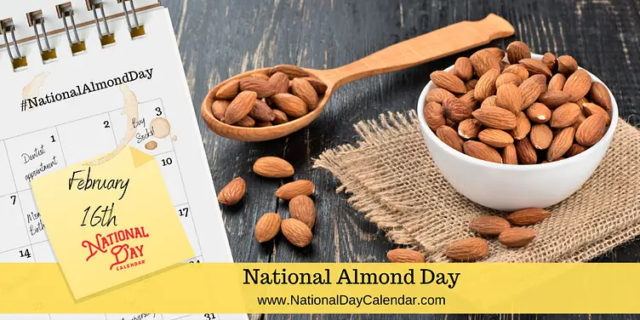
On February 16th each year, National Almond Day recognizes the versatile and healthful almond.
- According to a survey of 500 health professionals, almonds may be beneficial to a healthy lifestyle.
- According to the U.S. Food and Drug Administration, “Scientific evidence suggests, but does not prove that eating 1.5 ounces per day of most nuts, such as almonds, as part of a diet low in saturated fat and cholesterol, may reduce the risk of heart disease.”
- Recent research from Purdue University suggests that eating almonds can help people feel satisfied for several hours, which can support weight management and counter weight gain.
- Eighty percent of the world’s almonds are grown in California.
- Almonds are mentioned several times in the New and Old Testaments. They are revered as symbols of divine approval.
- Almonds are actually fruits, related to cherries and plums.
- Raw Almonds contain prussic acids, the eating of more than a handful can be lethal.
- A key indicator of cyanide poisoning was the faint smell of roasted almonds on the victim.
- Greek mythology tells of the beautiful princess Phyllis, who was left waiting at the altar on her wedding day by her intended, Demophon. Phyllis waited for years for him to return, but finally died of a broken heart. In sympathy, the gods transformed Phyllis into an almond tree, which became a symbol of hope.
- In the mid-1700s, the Franciscan Padres planted almond trees to grace their missions along El Camino Real (The Royal Road) that stretches along the California coast from San Diego to Sonoma.
- Cinnamon-glazed almonds were President Clinton’s snack of choice at both the 1993 and the 1997 inaugurations.
- Native to the Mediterranean countries, the almond was introduced to America from Spain in 1769.
- The world’s largest almond factory is located in Sacramento, California and processes over 2 million pounds of almonds per day. California produces over 80% of the world’s supply of almonds and that chocolate manufacturers currently use about 40% of the world’s almonds and about 20% of the world’s peanuts.
- The bitter taste in Almonds is derived from the 4-9 mg of hydrogen cyanide in each.
- Historians agree that almonds were one of the earliest cultivated foods.
- In 100 grams (3.5 ounces) raw almond supply 578 calories and are 73% fat, 14% carbs and 13% protein.
- Chocolate makers use 40% of the world’s total almonds in making delicious chocolates. Consumers worldwide believe almonds make chocolate more satisfying, uplifting and relaxing.
- The pollination of California’s almonds is the largest annual managed pollination event in the world, with close to one million hives (nearly half of all beehives in the US) being trucked in February to the almond groves. Much of the pollination is managed by pollination brokers, who contract with migratory beekeepers from at least 49 states for the event.
- Almonds are members of the rose family and are sometimes called “the queen of the rose family.”
- In the Bible the almond is mentioned ten times.
- One of the quintessential superfoods, almonds are packed with protein and vitamin E and are also a great source of fiber, calcium and iron.
- One of the best known features of Almonds is that they are the best cholesterol regulators
- Almonds have long storage life and can be refrigerated for up to 2 years.
- It takes 1000 pounds of almonds to make 1 pint of almond oil.
- Over 90 nations import California almonds, with Germany and Japan at the top of export consumption.
Sources:












